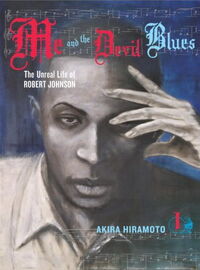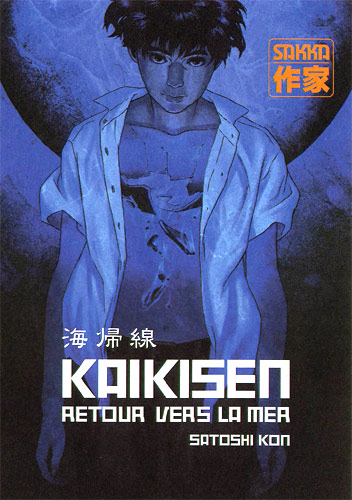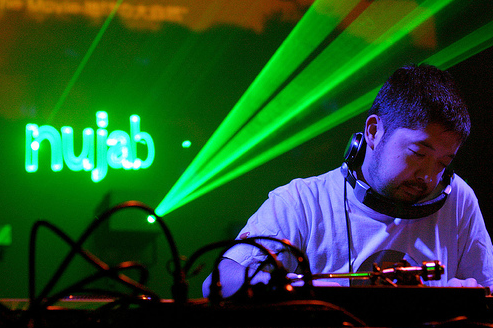Robert Johnson is a name instantly recognizable to any music fan, he is known world wide as the greatest blues man ever. But what is possibly even more iconic than his music is the legend about how he became so good. In many ways the story has out grown the man himself. The legend is so popular in fact that it has spawned a great manga titled Me and the Devil Blues. Named after Robert Johnson’s famous song this fallows the fictional tale of Robert Johnson after he has sold his soul to the devil.
As the manga begins Robert Johnson (a.k.a RJ) is a young, soon to be father, who works on a farm in the dirty south. But at night he and his friends like to unwind from a hard day’s work by heading down to the local bar and listening to the blues. But just listening to it isn’t enough for RJ he wants to play it. The problem is he sucks no matter how hard he tries. He is often laughed off stage every time he tries to pick up a guitar. One night though he hears the legend of the cross roads which claims that all you have to do is go down to the cross roads, play a song, and then the devil will appear. He’ll take your guitar, tune it, and play a few chords then from that day on you’ll be the greatest blues man around but you’ll have lost your soul. After hearing this story RJ ends up trying this out while a bit drunk and lost. But sure enough from that day on he could play the blues, and strange things happen to him. When he comes too he learns that he’d been away longer than he imagined, and life changing events occurred in his absence which sends him on the road, with no other companion other than the devil. The rest of the story consists of him running into one painful situation after another and letting the reader explore the early 1900’s south. The dark and gritty story breaths new life into the infamous myth and creates a compelling plot which will keep you at the edge of your seat.
Easily one of the strongest aspect of this title is the amazing art work through out the manga. The mangaka, Akira Hiramoto, is a rookie on the scene but with is first release has created quite a buzz about him. Anyone who picks up this manga will instantly notice the breath taking art work, dark shades and all. Now held up by many fans as a prime example of mangaka not complying to the typical “manga style” is uses incredibly detailed art unlike anything else on the scene. His style is truly his own and when you see his work there is no mistaking that Hiramoto had drawn that. It is so refreshing to see such a wonderfully crafted series being released. I truly can not even begin to explain just how well done the art work is. And reading the manga you get the feeling that every line and shade had a thoughtful purpose for being there. The art serves as a way to create mood, tone, and atmosphere is a brilliant way. And the moments when music is being played the style really shows how hard hitting the blues can be and it makes an attempt to capture that feeling on paper.
The story of this manga is extremely compelling and will definitely keep you on the edge of your seat as you patiently wait to see what comes next. I’m not sure if there’s any manga out there that I can really compare this work to. It’s a very unique story with a powerful movement about it that lets you linger in each scene just long enough to get the mood but not long enough to get bored. Another great thing about the writing is that Akira Hiramoto was able to paint the picture of depression era south in a brilliant way. The facts of it all is obviously not 100% accurate but he does have a way of making you feel like this is all actually taking place in that time period. He made sure to keep the time frame in mind while writing the story and drawing the pictures. On top of that throughout the story RJ runs into icons of the time like Clyde Barrow, one half of the most famous outlaw duo in history; Bonnie and Clyde. This appearance of such an iconic figure of that time further immerses you in the idea and feel of this time. And yes, seeing as the story’s main character is a young black man in the deep south, early 1900s America the issue of racism comes up quite often. But Hiramoto is able to illustrate this issue with great subtly and maturity making this a very compelling aspect of the plot.
Over all this is an amazing, yet not very popular, manga series that I think anyone who likes a good drama will enjoy. Currently Del Ray is releasing the first 4 volumes of this manga. But they are selling it buy combining two volumes into one so it appears that there is only 2 volumes in the U.S. (but don’t be fooled this is all 4 volumes). Unfortunately the mangaka has put this series on hiatuses and know one is quite sure why. So until he decides to finally start the series back up we just have to be content with the amazing work that we have available to us now. If you are fan of manga, drama, Robert Johnson, or even just a fan of good stories you will not be disappointed in checking this series out. So to end it of I’ll conclude with a quote from the song Me and the Devil Blues (the song which inspired the title of the manga) “Early this morning, when you knocked upon my door. And I said hello Satan I believe it’s time to go.”
This is supposed to be Kazuo Umezu, right?
10 years ago





